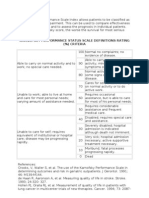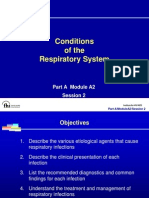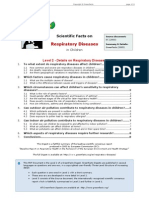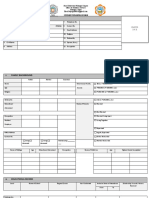Karnofsky Performance Scale Index
Karnofsky Performance Scale Index
Uploaded by
Amolkumar W DiwanCopyright:
Available Formats
Karnofsky Performance Scale Index
Karnofsky Performance Scale Index
Uploaded by
Amolkumar W DiwanCopyright
Available Formats
Share this document
Did you find this document useful?
Is this content inappropriate?
Copyright:
Available Formats
Karnofsky Performance Scale Index
Karnofsky Performance Scale Index
Uploaded by
Amolkumar W DiwanCopyright:
Available Formats
The Karnofsky Performance Scale Index allows patients to be classified as to their functional impairment.
This can be used to compare effectiveness of different therapies and to assess the prognosis in individual patients. The lower the Karnofsky score, the worse the survival for most serious illnesses.
KARNOFSKY PERFORMANCE STATUS SCALE DEFINITIONS RATING (%) CRITERIA
100 Able to carry on normal activity and to work; no special care needed. 90 80 70 Unable to work; able to live at home and care for most personal needs; varying amount of assistance needed. 60 50 40 30 Unable to care for self; requires equivalent of institutional or hospital care; disease may be progressing rapidly. Normal no complaints; no evidence of disease. Able to carry on normal activity; minor signs or symptoms of disease. Normal activity with effort; some signs or symptoms of disease. Cares for self; unable to carry on normal activity or to do active work. Requires occasional assistance, but is able to care for most of his personal needs. Requires considerable assistance and frequent medical care. Disabled; requires special care and assistance. Severely disabled; hospital admission is indicated although death not imminent. Very sick; hospital admission necessary; active supportive treatment necessary. Moribund; fatal processes progressing rapidly. Dead
20 10 0
References: Crooks, V, Waller S, et al. The use of the Karnofsky Performance Scale in determining outcomes and risk in geriatric outpatients. J Gerontol. 1991; 46: M139-M144. de Haan R, Aaronson A, et al. Measuring quality of life in stroke. Stroke. 1993; 24:320- 327. Hollen PJ, Gralla RJ, et al. Measurement of quality of life in patients with lung cancer in multicenter trials of new therapies. Cancer. 1994; 73: 2087-2098. O'Toole DM, Golden AM. Evaluating cancer patients for rehabilitation potential. West J Med. 1991; 155:384-387. Oxford Textbook of Palliative Medicine, Oxford University Press. 1993;109.
Schag CC, Heinrich RL, Ganz PA. Karnofsky performance status revisited: Reliability, validity, and guidelines. J Clin Oncology. 1984; 2:187-193.
Performance status
What is the WHO performance scale and how does this help doctors decide who can go on a clinical trial or not? Doctors use the WHO performance scale to describe how well you are. They also call it your performance status. There are different ways of assessing general health. The World Health Organisation designed the scale that doctors use most often. It has categories from 0 to 4. Here is what they mean
0 you are fully active and more or less as you were before your illness 1 you cannot carry out heavy physical work, but can do anything else 2 you are up and about more than half the day and can look after yourself, but are not well
enough to work 3 you are in bed or sitting in a chair for more than half the day and you need some help in looking after yourself
4 you are in bed or a chair all the time and need a lot of looking after
Another commonly used scale is the Karnofsky performance status. It is similar to the WHO scale, but goes to up 100.
100 you dont have any evidence of disease and feel well 90 you only have minor signs or symptoms but are able to carry on as normal 80 you have some signs or symptoms and it takes a bit of effort to carry on as normal 70 you are able to care for yourself but not able to carry on with all your normal activities or
do active work
60 you need help from time to time but can mostly care for yourself 50 you need quite a lot of help to care for yourself 40 you always need help to care for yourself 30 you are disabled and may need to stay in hospital 20 you are ill, in hospital and need a lot of treatment 10 you are very ill and unlikely to recover
Clinical trials often include performance status as one of the criteria you must meet to join the trial. Researchers have to make sure that people are well enough to take part in a trial. You must be able
to withstand the treatment they are testing. And, it sounds harsh, but for some trials they have to make sure that the people taking part live long enough for the trial to get results. There is no point testing a treatment to see if it improves 5 year survival if the people being tested don't live for at least 5 years. Researchers use a set scale because it makes sure that all the patients who join are assessed in the same way.
FAST FACTS AND CONCEPTS #125 Author(s): L Scott Wilner MD and Robert Arnold MD Background A ccurate prognostic information is important for patients, families and physicians. This Fast Fact reviews the Palliative Performance Scale; see Fast Fact #124 The Palliative Prognostic Score for another prognostic tool used in palliative care patients. The Palliative Performance Scale (PPS) uses five observer-rated domains correlated to the Karnofsky Performance Scale (100-0). The PPS is a reliable and valid tool and correlates well with actual survival and median survival time for cancer patients. It has been found useful for purposes of identifying and tracking potential care needs of palliative care patients, particularly as these needs change with disease progression. Large validation studies are still needed, as is analysis of how the PPS does, or does not, correlate with other available prognostic tools and commonly used symptom scales.
PALLIATIVE PERFORMANCE SCALE (PPS)
Activity Level % Ambulation Evidence of Disease Self-Care Intake Level of Consciousness
Estimated Median Survival in Days (a) (b) (c)
Normal 100 Full No Disease Normal 90 Full Some Disease 80 Full Normal with Effort Full Normal or Reduced Full Full Normal Full N/A N/A 108 Full Normal Full
Some Disease Can't do normal job 70 Reduced or work Some Disease Can't do hobbies or housework Significant Disease Can't do any work Extensive Disease As above in Bed 30 Bed Bound 20 Bed Bound 10 Bed Bound 0 Death As above As above As above Occasional Assistance Needed Full As above Full 145
60
Reduced
As above Full or Confusion 29
50
Mainly sit/lie
Considerable Assistance Needed
As above Full or Confusion 30
11 41
Mainly 40
Mainly Assistance Total Care As above As above -
As above Reduced Minimal
Full or Drowsy or 18 Confusion As above As above 8 4 1
8 5 2 6 1
Mouth Drowsy or Coma Care Only --
a. b. c.
Survival post-admission to an inpatient palliative unit, all diagnoses (Virik 2002). Days until inpatient death following admission to an acute hospice unit, diagnoses not specified (Anderson 1996). Survival post admission to an inpatient palliative unit, cancer patients only (Morita 1999).
References 1. 2. 3. Anderson F, Downing GM, Hill J. Palliative Performance Scale (PPS): a new tool. J Palliat Care. 1996; 12(1): 5-11. Morita T, Tsunoda J, Inoue S, et al. Validity of the Palliative Performance Scale from a survival perspective. J Pain Symp Manage. 1999; 18(1):2-3. Virik K, Glare P. Validation of the Palliative Performance Scale for inpatients admitted to a palliative care unit in Sydney, Australia. J Pain Symp Manage. 2002; 23(6):455-7.
Fast Facts and Concepts are edited by Drew A Rosielle MD, Palliative Care Center, Medical College of Wisconsin. For more information write to: drosiell@mcw.edu. More information, as well as the complete set of Fast Facts, are available at EPERC: www.eperc.mcw.edu. Version History: This Fast Fact was originally edited by David E Weissman MD and published in November 2004. Current version re-copy-edited in April 2009. Copyright/Referencing Information: Users are free to download and distribute Fast Facts for educational purposes only. Wilner LS, Arnold R. The Palliative Performance Scale. Fast Facts and Concepts. November 2004; 125. Available at: http://www.eperc.mcw.edu/fastfact/ff_125.htm. Disclaimer: Fast Facts and Concepts provide educational information. This information is not medical advice. Health care providers should exercise their own independent clinical judgment. Some Fast Facts cite the use of a product in a dosage, for an indication, or in a manner other than that recommended in the product labeling. Accordingly, the official prescribing information should be consulted before any such product is used. ACGME Competencies: Medical Knowledge, Patient Care Keywords: Prognosis
ECOG Performance Status
These scales and criteria are used by doctors and researchers to assess how a patient's disease is progressing, assess how the disease affects the daily living abilities of the patient, and determine appropriate treatment and prognosis. They are included here for health care professionals to access.
ECOG PERFORMANCE STATUS* Grade ECOG 0 1 Fully active, able to carry on all pre-disease performance without restriction Restricted in physically strenuous activity but ambulatory and able to carry out work of a light or sedentary nature, e.g., light house work, office work Ambulatory and capable of all selfcare but unable to carry out any work activities. Up and about more than 50% of waking hours
3 4 5
Capable of only limited selfcare, confined to bed or chair more than 50% of waking hours Completely disabled. Cannot carry on any selfcare. Totally confined to bed or chair Dead
* As published in Am. J. Clin. Oncol.: Oken, M.M., Creech, R.H., Tormey, D.C., Horton, J., Davis, T.E., McFadden, E.T., Carbone, P.P.: Toxicity And Response Criteria Of The Eastern Cooperative Oncology Group. Am J Clin Oncol 5:649-655, 1982. The ECOG Performance Status is in the public domain therefore available for public use. To duplicate the scale, please cite the reference above and credit the Eastern Cooperative Oncology Group, Robert Comis M.D., Group Chair. Next topic
How to contact ECOG All contents copyright 1998-2000 Eastern Cooperative Oncology Group. All rights reserved. Revised: July 27, 2006
You might also like
- Prep 2023Document909 pagesPrep 2023Imran A. Isaac100% (7)
- Nur 151: P1 Examination Part 1: EmailDocument13 pagesNur 151: P1 Examination Part 1: EmailJilkiah Mae Alfoja Campomanes100% (2)
- SCIO Study - Bicom & LupusDocument23 pagesSCIO Study - Bicom & LupusDonny Winardi100% (1)
- Patient AssesmentDocument15 pagesPatient AssesmentDyah Arum KusumaningtyasNo ratings yet
- 1st Year Psychology NotesDocument46 pages1st Year Psychology NotesEugene de RooyNo ratings yet
- The Karnofsky Performance Scale Index Allows Patients To Be Classified As To Their Functional ImpairmentDocument2 pagesThe Karnofsky Performance Scale Index Allows Patients To Be Classified As To Their Functional ImpairmentraisaadhibaNo ratings yet
- PrognosisDocument6 pagesPrognosiswisnurendraNo ratings yet
- Disusun Oleh: Roseane Maria Dan Vidianka Rembulan: Karnofsky Performance Status Scale Definitions Rating (%) CriteriaDocument2 pagesDisusun Oleh: Roseane Maria Dan Vidianka Rembulan: Karnofsky Performance Status Scale Definitions Rating (%) CriteriaDiano Ramadhan FauzanNo ratings yet
- SOAP - Case Study FormatsDocument8 pagesSOAP - Case Study FormatsDr-Sanjay SinghaniaNo ratings yet
- Performance StatusDocument1 pagePerformance Statusribeth2011No ratings yet
- BSN II RLE Concept AutosavedDocument85 pagesBSN II RLE Concept AutosavedJoycee BoNo ratings yet
- Clinical GuidelinesDocument7 pagesClinical GuidelinesGloriaNo ratings yet
- Nursing AssessmentDocument28 pagesNursing AssessmentKierstine Joy YamatNo ratings yet
- Lectura 1 AfDocument10 pagesLectura 1 AfCésar Alfonso Hernández NonajulcaNo ratings yet
- Assessment of The Perceived Quality of Life of Non Insulin Dependent Diabetic Patients Attending The Diabetes Clinic in Kenyatta National HospitalDocument7 pagesAssessment of The Perceived Quality of Life of Non Insulin Dependent Diabetic Patients Attending The Diabetes Clinic in Kenyatta National HospitalIOSR Journal of PharmacyNo ratings yet
- AOA Survival Guide To The 2nd YearDocument18 pagesAOA Survival Guide To The 2nd Yearmediquest100% (1)
- The Karnofsky Performance Status Scale PDFDocument6 pagesThe Karnofsky Performance Status Scale PDFJuan David EcheverriNo ratings yet
- Hang OutDocument92 pagesHang OutMadhu UpadhyayNo ratings yet
- (Osborn) Chapter 10 Learning Objectives (Number and Title)Document22 pages(Osborn) Chapter 10 Learning Objectives (Number and Title)KittiesNo ratings yet
- Module 4 NRSG780Document9 pagesModule 4 NRSG780justdoyourNo ratings yet
- Health AssessmentDocument25 pagesHealth AssessmentGovindaraju Subramani100% (1)
- Nursing AssessmentDocument16 pagesNursing AssessmentJihan Novita100% (1)
- CCJM Symptom Management An Important Part of Cancer CareDocument10 pagesCCJM Symptom Management An Important Part of Cancer CareBrian HarrisNo ratings yet
- Periodic Health ExaminationDocument38 pagesPeriodic Health ExaminationHilma NadhifaNo ratings yet
- Screening For Disease PPT HadeelDocument10 pagesScreening For Disease PPT Hadeelalihaiderinad0No ratings yet
- Clniical ReasoningDocument30 pagesClniical Reasoningnunu ahmedNo ratings yet
- 16.nursing Care PlanDocument33 pages16.nursing Care PlanyaraNo ratings yet
- Learner Skill ValidationDocument7 pagesLearner Skill ValidationPaul Zantua33% (3)
- 2-Week 1-Introduction To PathophysiologyDocument22 pages2-Week 1-Introduction To Pathophysiologys140138No ratings yet
- Prognostic Scoring: Guideline For Estimating Length of Survival in Palliative PatientsDocument5 pagesPrognostic Scoring: Guideline For Estimating Length of Survival in Palliative Patientstitis dwi tantiNo ratings yet
- Thyroid Disease During PregnancyDocument15 pagesThyroid Disease During PregnancyAnonymous ysrxggk21cNo ratings yet
- Clinical Exam. & History TakingDocument23 pagesClinical Exam. & History TakingManiish Trivedi100% (2)
- Palliative Performance Scale (PPS) : DescriptionDocument4 pagesPalliative Performance Scale (PPS) : DescriptionIKA SYAMSUL HUDA MZNo ratings yet
- ESRD Secondary To Diabetic Nephropathy CASE STUDYDocument42 pagesESRD Secondary To Diabetic Nephropathy CASE STUDYRalph Pelegrino75% (4)
- Clinical Evaluation in Rehabilitation Practice Copy 2Document23 pagesClinical Evaluation in Rehabilitation Practice Copy 2Queen SofiaNo ratings yet
- Saudi Center EBDocument130 pagesSaudi Center EBAnonymous hF5zAdvwCCNo ratings yet
- Health Psychology and Behavioral Medicine: An Open Access JournalDocument10 pagesHealth Psychology and Behavioral Medicine: An Open Access JournalViviana PueblaNo ratings yet
- Self-Management in Older Patients With Chronic Illness: ResearchpaperDocument11 pagesSelf-Management in Older Patients With Chronic Illness: ResearchpaperAlberto MeroNo ratings yet
- Barthel IndexDocument2 pagesBarthel IndexWilLy TaniaNo ratings yet
- The Wheel of Compliance: DR Ahmed Shoka Consultant PsychiatristDocument47 pagesThe Wheel of Compliance: DR Ahmed Shoka Consultant PsychiatristWalidur Rahman MridulNo ratings yet
- Duloxetine Treatment For GADDocument8 pagesDuloxetine Treatment For GADWhitney FarrarNo ratings yet
- Introduction To Evidence Based MedicineDocument66 pagesIntroduction To Evidence Based MedicinerizaNo ratings yet
- PubMedHealth PMH0091057Document377 pagesPubMedHealth PMH0091057Jose ManuelNo ratings yet
- Qol in DialysisDocument6 pagesQol in Dialysism29hereNo ratings yet
- DischargeDocument49 pagesDischargejonel_amarille100% (1)
- Assessment of Older Adults Powerpoint Rebecca WinsorDocument19 pagesAssessment of Older Adults Powerpoint Rebecca WinsorRose Antonette BenitoNo ratings yet
- ESRD Secondary To Diabetic Nephropathy CASE STUDY Docx 2Document42 pagesESRD Secondary To Diabetic Nephropathy CASE STUDY Docx 2Eyerusalem100% (1)
- MH Case StudyDocument17 pagesMH Case StudyS. JacobsNo ratings yet
- How To Write A SOAPDocument4 pagesHow To Write A SOAPRameshNo ratings yet
- Geri Assess Tools ArticleDocument9 pagesGeri Assess Tools ArticleThesmith FamNo ratings yet
- 7.pain MNJM in Elder PopulationDocument9 pages7.pain MNJM in Elder PopulationRiantiara PutrizaNo ratings yet
- Novel Evidence-Based Systemic Lupus Erythematosus Responder IndexDocument9 pagesNovel Evidence-Based Systemic Lupus Erythematosus Responder IndexAlisNo ratings yet
- JournalDocument31 pagesJournalNandini VermaNo ratings yet
- Presented by DR Muhammad Usman Senior Lecturer BUCPT: Introduction To Screening For Referral in Physical TherapyDocument27 pagesPresented by DR Muhammad Usman Senior Lecturer BUCPT: Introduction To Screening For Referral in Physical Therapysaba ramzanNo ratings yet
- Comprehensive Geriatric Assessment Diagram Hey (Draw The Diagram)Document4 pagesComprehensive Geriatric Assessment Diagram Hey (Draw The Diagram)Debipriya MistryNo ratings yet
- Jurnal UtamaDocument8 pagesJurnal UtamaUhti JahrotunisaNo ratings yet
- Screening For Good Health: The Australian Guide To Health Screening And ImmunisationFrom EverandScreening For Good Health: The Australian Guide To Health Screening And ImmunisationNo ratings yet
- Physician Assistant PANCE & PANRE: a QuickStudy Laminated Reference GuideFrom EverandPhysician Assistant PANCE & PANRE: a QuickStudy Laminated Reference GuideNo ratings yet
- So You Wanna Be A Doctor? The Untold Stories Of Medical, Dental, and Veterinary ResidentsFrom EverandSo You Wanna Be A Doctor? The Untold Stories Of Medical, Dental, and Veterinary ResidentsNo ratings yet
- The Great Health Heist: An Introduction to Nutrition Response TestingFrom EverandThe Great Health Heist: An Introduction to Nutrition Response TestingNo ratings yet
- Allergy Shots (Allergy ImmunotherapyDocument6 pagesAllergy Shots (Allergy ImmunotherapyAmolkumar W DiwanNo ratings yet
- TB MCQ UseDocument12 pagesTB MCQ UseAmolkumar W Diwan100% (6)
- Conditions of Respi SystemDocument20 pagesConditions of Respi SystemAmolkumar W DiwanNo ratings yet
- Kimuras - Disease Unusual Cause of Cervical TumorDocument4 pagesKimuras - Disease Unusual Cause of Cervical TumorAmolkumar W DiwanNo ratings yet
- Herb A LifeDocument97 pagesHerb A LifeAmolkumar W DiwanNo ratings yet
- Pleural DiseasesDocument52 pagesPleural DiseasesAmolkumar W DiwanNo ratings yet
- Chapter 2Document40 pagesChapter 2Amolkumar W DiwanNo ratings yet
- Burden of Disease in India NCMCHDocument388 pagesBurden of Disease in India NCMCHBrand Synapse100% (1)
- Epidemiology of Childhood AsthmaDocument4 pagesEpidemiology of Childhood AsthmaAmolkumar W DiwanNo ratings yet
- Cellular Respiration: Food ATPDocument43 pagesCellular Respiration: Food ATPAmolkumar W DiwanNo ratings yet
- Respiratory Diseases Green Facts Level2Document11 pagesRespiratory Diseases Green Facts Level2Amolkumar W DiwanNo ratings yet
- Bupc Student Profile FormDocument4 pagesBupc Student Profile FormJohn ChicogoNo ratings yet
- 1ST Summative Test-Health ViDocument4 pages1ST Summative Test-Health ViDell Nebril SalaNo ratings yet
- Acute AbdomenDocument7 pagesAcute AbdomenchloeNo ratings yet
- Maternal and Child NursingDocument46 pagesMaternal and Child NursingDarnell Adrian Estobio67% (3)
- Intestinal Autoimmunity NEWDocument6 pagesIntestinal Autoimmunity NEWAbdalazeez AlsayedNo ratings yet
- Food Safety PresentationDocument15 pagesFood Safety Presentationapi-276876378No ratings yet
- CamScanner 09-04-2023 13.33Document4 pagesCamScanner 09-04-2023 13.33BILAL AYALANo ratings yet
- Group 4's PresentationDocument5 pagesGroup 4's PresentationCleo VillanuevaNo ratings yet
- Soft Tissue Infection by SlidesgoDocument40 pagesSoft Tissue Infection by SlidesgoDurga MadhuriNo ratings yet
- Ent-Book2 009 PDFDocument186 pagesEnt-Book2 009 PDFMariana Salgar100% (2)
- Pink and Blue Lung Cancer Awareness Presentation - 20230808 - 202358 - 0000Document32 pagesPink and Blue Lung Cancer Awareness Presentation - 20230808 - 202358 - 0000ashmitav8m10402No ratings yet
- An Overview of AIDS Dementia ComplexDocument5 pagesAn Overview of AIDS Dementia Complexcathe284No ratings yet
- Dampd 5 Manual Del Jugador EspDocument24 pagesDampd 5 Manual Del Jugador EspClaudio ReichelNo ratings yet
- Clinmed 17 1 84Document2 pagesClinmed 17 1 84little luluNo ratings yet
- Epidemiology: Assistant Professor Punjab University College of PharmacyDocument20 pagesEpidemiology: Assistant Professor Punjab University College of PharmacyUsama AmjadNo ratings yet
- Maternal Adaptation To PregnancyDocument57 pagesMaternal Adaptation To PregnancyQuolette Constante100% (6)
- Energy BalanceDocument29 pagesEnergy BalanceAlinta AyuningtyasNo ratings yet
- Module 1 in TLE 9 WK 1 2nail CareDocument10 pagesModule 1 in TLE 9 WK 1 2nail CareAdrian AgaNo ratings yet
- Introduction To Chaining: - There Are Two Main Types of Inference in Expert SystemsDocument5 pagesIntroduction To Chaining: - There Are Two Main Types of Inference in Expert SystemsSanjay KumarNo ratings yet
- Mexican Bed BugDocument10 pagesMexican Bed BugPatrick Ross Serquiña DulayNo ratings yet
- June Free Chapter - Fairytales For Wilde Girls by Allyse NearDocument25 pagesJune Free Chapter - Fairytales For Wilde Girls by Allyse NearRandomHouseAUNo ratings yet
- Module 2 Hazards To Food Safety by JeleaneDocument26 pagesModule 2 Hazards To Food Safety by JeleanepagdatoalayzamaeNo ratings yet
- UntitledDocument20 pagesUntitledstuffednurse100% (1)
- Religious Involvement 17Document3 pagesReligious Involvement 17Keanu PeraltaNo ratings yet
- E&M Coding Tool: Level: Level: Level: Total Time On Dos: LevelDocument2 pagesE&M Coding Tool: Level: Level: Level: Total Time On Dos: LevelKAREEN FERRICK0% (1)
- Diseases of The External EarDocument20 pagesDiseases of The External EarFabian LitetaNo ratings yet
- Diarrhea - StatPearls - NCBI BookshelfDocument4 pagesDiarrhea - StatPearls - NCBI BookshelfIndira SellyNo ratings yet
- Oral Viral Infections Diagnosis and Management PDFDocument13 pagesOral Viral Infections Diagnosis and Management PDFWesley Rodrigues100% (1)




































































































